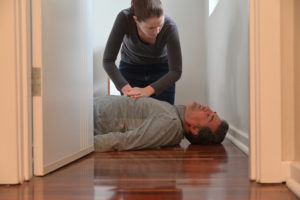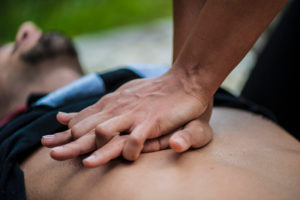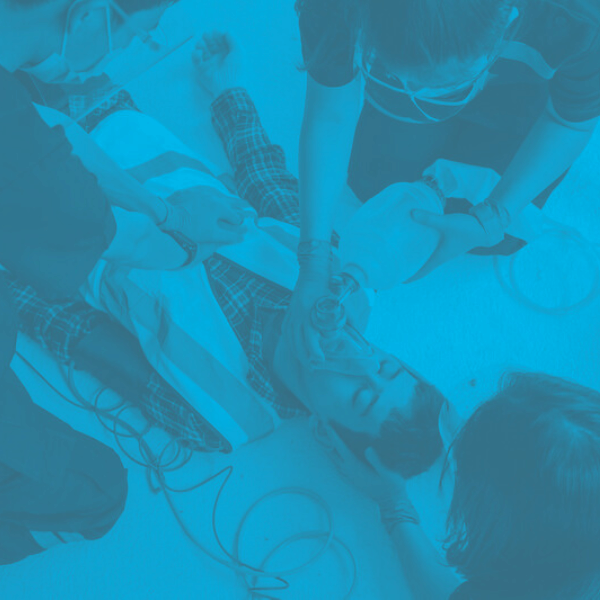10 Things You May Not Know About CPR
10 Things You May Not Know About CPR

by Greta Kviklyte
Life Saver, AMC
Co-authored by Kim Murray, RN, M.S.
posted on Mar 18, 2022, at 6:10 am
Cardiopulmonary resuscitation (CPR) is an important emergency lifesaving technique that can be used when somebody’s heart suddenly stops beating. If given right away, CPR can double or even triple the chances that someone will survive cardiac arrest.
Whether you are a professional rescuer, future health care professional, or simply a layperson who is interested in CPR and first aid training, it’s helpful to educate yourself about this lifesaving technique and be aware of some common but perhaps surprising facts. With this in mind, here are ten things you forgot or might not know about CPR:
We offer Online CPR and BLS Certification
1. State laws exist that protect lay rescuers.
 All 50 U.S. states have some variation of what is known as “Good Samaritan” laws. These laws provide legal protection to non-professional rescuers who give CPR to people suffering from cardiac arrest.
All 50 U.S. states have some variation of what is known as “Good Samaritan” laws. These laws provide legal protection to non-professional rescuers who give CPR to people suffering from cardiac arrest.
A layperson is considered a Good Samaritan if they are trying to help someone in distress, are not being specifically compensated for performing CPR, and are acting reasonably (i.e., not engaging in gross misconduct or doing something that a reasonable person would not do).
While many individuals feel that they have a moral or ethical obligation to attempt to revive someone using CPR and other first aid techniques, non-professional rescuers have no legal obligation to give someone CPR, at least in most states. And according to the course providers, no lay rescuer has ever been successfully sued for attempting to give someone CPR.
2. You do not have to be certified in CPR in order to give CPR.
People can perform CPR even if they have never had any formal training, according to the Resque7. In fact, research from 2007 found that kids as young as thirteen can give CPR as effectively as most adults and that kids as young as nine should be offered the opportunity to learn CPR.
Untrained rescuers can simply perform the CDC’s recommended “hands-only” technique, which involves chest compressions given at a rate of 100 to 120 beats per minute.
3. At least five critical components to high-quality CPR are recognized.
We know now that anyone can give CPR to someone who is suffering from cardiac arrest, even if the rescuer has had no formal training. That said, formal training can certainly help improve the quality of CPR given!
To maximize the effectiveness and safety of CPR, at least five critical components that rescuers should keep in mind are:
- Chest compressions should be interrupted as little as possible.
- Chest compressions should be provided at the appropriate rate and to the appropriate depth (which depends on victim characteristics and the number of rescuers present).
- Rescuers should avoid leaning on the victim between compressions. This helps to ensure that there is appropriate chest recoil.
- Rescuers should ensure that they have proper hand placement for chest compressions (which depends on the size and age of the victim)
- If ventilation is being provided, rescuers should avoid excessive ventilation.
All of these components and more are discussed in detail in high-quality CPR training courses.
4. You do not necessarily have to wait until someone completely stops breathing before performing CPR.
As described in 2017 guidelines from the Institute for Quality and Efficiency in Healthcare, a rescuer does not necessarily have to wait until a person completely stops breathing before performing CPR. This is because a person might still breathe for a short amount of time even after their heart stops beating—although their breath will not appear normal.
The breathing pattern of a person suffering cardiac arrest might look or sound:
- Irregular
- Deep
- Slow
- Noisy (often described as a snoring or gasping sound)
Eventually, a person who is in cardiac arrest will stop breathing completely. But rescuers can begin CPR even before this happens, so long as the victim is unconscious and the rescuer suspects that the victim is breathing abnormally.
Remember, when it comes to helping someone survive cardiac arrest, time is of the essence. For every minute that a person in cardiac arrest goes without CPR, their chances of a full recovery decrease by about 7 to 10 percent, according to a 2019 article from the New England Journal of Medicine.
5. It is not uncommon for a victim’s ribs to break during CPR.
 Chest compressions must be forceful enough to externally squeeze the heart and help it pump blood throughout the body. For this reason, a person giving chest compressions to a cardiac arrest victim might end up pressing hard enough to break some of the victim’s ribs or sternum (breastbone).
Chest compressions must be forceful enough to externally squeeze the heart and help it pump blood throughout the body. For this reason, a person giving chest compressions to a cardiac arrest victim might end up pressing hard enough to break some of the victim’s ribs or sternum (breastbone).
Broken bones are not an indicator that CPR was good or bad. They are simply a relatively common and sometimes unavoidable complication of CPR itself. Factors related to the victim, including the victim’s age, gender, and overall health status, can also influence how likely it is for rib or sternum fractures to occur.
Other health complications during CPR are possible. These include lung injuries (eg., pneumothorax or lung contusions), injuries to abdominal organs (e.g., liver or spleen), and chronic or subacute chest pain. Fortunately, research indicates that the overall risk and frequency of CPR complications are generally low.
6. A victim might vomit during CPR.
Vomiting is considered a sign of life, and some victims will vomit while receiving rescue breaths or chest compressions. If a victim appears to vomit during CPR, here’s what you should do, depending on the situation:
- A lone rescuer may stop to clear the airway of large amounts of vomit before resuming CPR, or after administering a shock as advised by an AED. Smaller amounts of saliva and foam in the mouth do not need to be cleared out of the airway, until and unless the rescuer performs rescue breathing.
- If there are two trained rescuers, one rescuer can turn the victim’s head to the side (assuming there are no spinal injuries suspected) and clear the airway of vomit as the other rescuer continues to perform chest compressions until ventilations or shocks via an AED are required.
When in doubt, continue with chest compressions.
7. People can record you doing CPR.
When a victim goes into cardiac arrest in a public place—such as in an airport, a mall, a restaurant, or a park—it’s not uncommon for bystanders to take out their cellphones and start recording. Knowing that they are being recorded might make some people reluctant to start helping a victim out of fear of future litigation.
The question is: can people record you giving someone CPR in public even if you don’t give them permission to do so?
Generally speaking, yes. In the United States, it is not considered illegal to videotape someone in public without their consent if they are in a public place and do not have a reasonable expectation of privacy. However, different states have different laws and regulations pertaining to how many people must agree to a recording (e.g., one-party vs two-party consent).
A helpful reminder:
When assessing or reassessing an adult victim’s ABC’s (airway, breathing, and circulation), it’s considered good practice to check for the person’s pulse on the same side of the neck that you’re kneeling or standing next to. This is so that you are not reaching your hand over their neck, which can make it look like you are choking the victim, even though you aren’t.
8. It is unlikely but possible to become infected with a communicable disease while performing CPR.
Transmission of infectious diseases is rare but can happen while someone is administering CPR or other types of first aid. In fact, this is one reason why many people are scared or reluctant to come to someone’s aid if they collapse due to cardiac arrest.
The types of diseases or organisms that could potentially be transmitted during CPR include:
- SARS-CoV-2
- HIV
- HBV
- HCV
- HSV
- Ebola
- Clostridium difficile
- Salmonella
- Helicobacter pylori
- Shigella
- MERS-CoV
- CMV
- Measles
- Mycobacterium tuberculosis
- Influenza
These infectious pathogens can be transmitted via a number of different routes, including airborne, droplet, contact, or hematogenous transmission. For example, if a rescuer has a cut or wound that gets exposed to the blood or bodily fluid of a victim with a blood-borne pathogen, there is a chance that the rescuer can become infected with that pathogen. As another example, a CPR provider might also unintentionally inhale infectious respiratory droplets from a victim who is sick with the flu or COVID-19, and potentially expose themselves to the coronavirus or flu virus.
Fortunately, the actual reported incidence of infectious disease transmission during CPR is quite low worldwide, according to a 2021 study published in Clinical Microbiology.
You deserve to be as safe as possible while attempting to give someone CPR. While it’s not always practical nor possible to stop and don personal protective equipment (PPE) before going to help someone, you might want to stock up on some gloves, CPR mouth barriers, N95 respirators or surgical masks, and/or goggles in your car, home, or office. Always perform proper hand hygiene after giving CPR.
And remember: you do not have to give someone mouth-to-mouth if you are a lay rescuer. Hands-only CPR is appropriate in many situations.
9. Giving CPR does not guarantee that a cardiac arrest victim will survive.
Unfortunately, statistics show that about 90 percent of people who experience cardiac arrest outside of the hospital die. Even if CPR is provided, the chances that someone will survive the ordeal are much lower than what most people might think.
One 2018 study from The American Journal of Emergency Medicine notes that the average rate of survival—from initial cardiac arrest to discharge from a hospital—is approximately 10.6 percent. Many cardiac arrest survivors who are revived through CPR and other first-aid measures will suffer life-long health issues, including chronic neurological and cardiovascular damage.
Even so, knowing how to perform CPR as a bystander rescuer can improve the likelihood that someone you know will survive an out-of-hospital cardiac arrest. Keep in mind that more than 70% of the 350,000 cardiac arrests occurring outside the hospital every year in the United States happen inside a person’s home. So, knowing how to perform high-quality CPR for a loved one suffering from cardiac arrest can help them survive until paramedics arrive.
Whether a cardiac arrest victim survives or not, CPR can be a traumatic experience for both professional and non-professional rescuers. If you tried to help someone in distress and are having a difficult time processing the experience, please speak to someone or meet with a licensed mental health professional who can offer guidance and assistance.
10. There are many reasons to stop CPR.
When giving CPR to a victim of cardiac arrest, it is not unusual to worry about when and whether to stop giving CPR. How long should a person continue before stopping? For the lay rescuer, there are actually several reasons to stop that are considered acceptable by the CPR training providers:
- The victim begins to move or shows signs of consciousness.
- Someone brings an automated external defibrillator or AED. (If there are two or more helpers, it is appropriate for one person to continue giving chest compressions while another rescuer sets up and prepares the AED. However, CPR should be paused while adhering to the defibrillator pads and while the AED is on and actively assessing a person’s heart rate. Fortunately, most AED devices today come with automated voice prompts to instruct rescuers when and whether to resume CPR.)
- Paramedics or other professional helpers arrive or tell the rescuer to stop.
- The rescuer becomes too tired to continue.
- The situation or surroundings become too dangerous for the rescuer to continue.
- Signs of death are obvious and apparent.
Would You Like to Receive Your BLS Certification or Recertification Online?
Advanced Medical Certification is a leading online resource for BLS, PALS, and ACLS certification courses. AMC certifications are accepted nationwide and come with a full money-back guarantee. Visit our website and learn more about our diverse range of certifications and re-certification courses. Share your wisdom and thoughts in the comments below, or head on over to the discussion about this post on Facebook.




very good jon bro. very useful to me cute
Thank you! We are happy that you found the information helpful. Please share with your friends and coworkers!
Your blog has helped me become a more positive and mindful person I am grateful for the transformative effect your words have had on me
Thank you so much for your kind words! We’re grateful to hear that our blog has had a positive impact on you. Stay mindful and keep up the great work on your journey! 😊
This is such an important reminder and one that I needed to hear today Thank you for always providing timely and relevant content
Your passion for what you do is evident in every post It’s inspiring to see someone truly fulfilling their purpose and making a positive impact
That’s such a kind and encouraging comment; thank you for noticing!